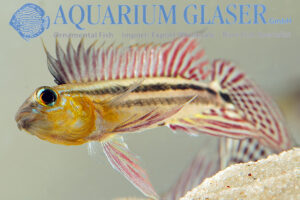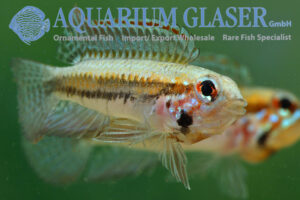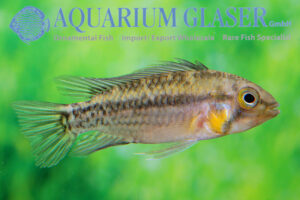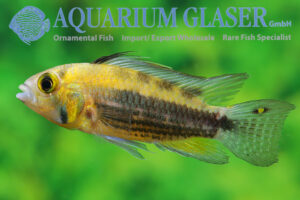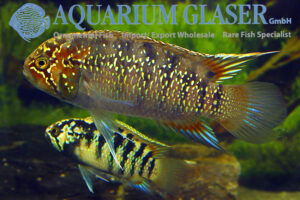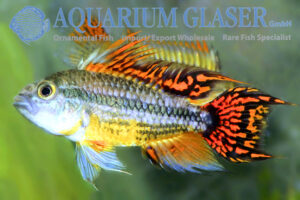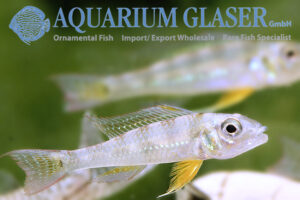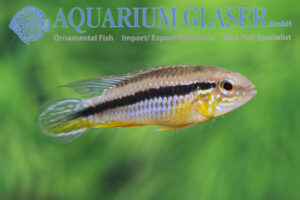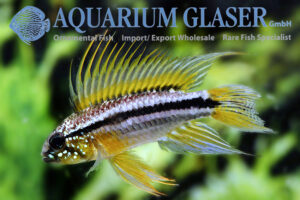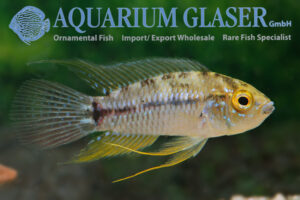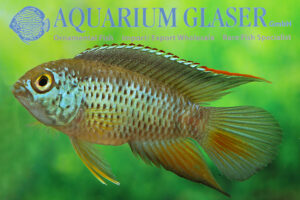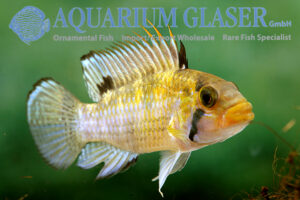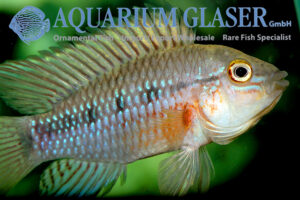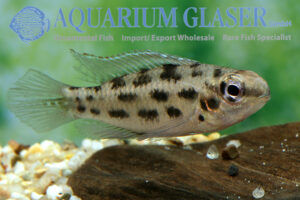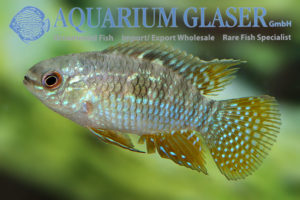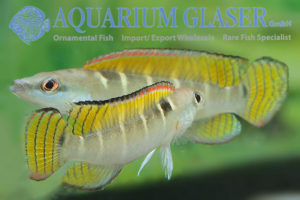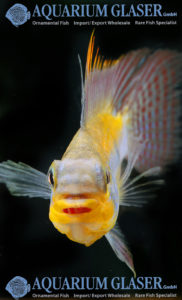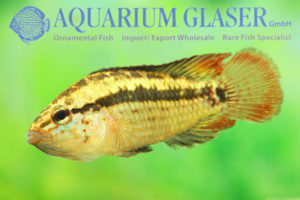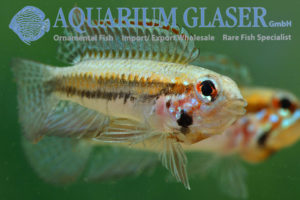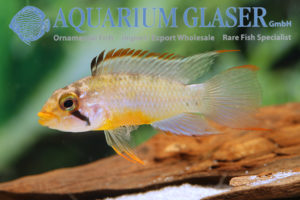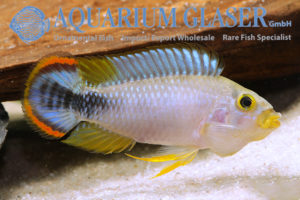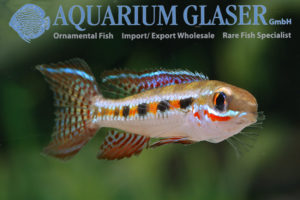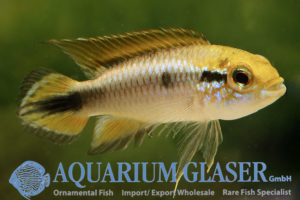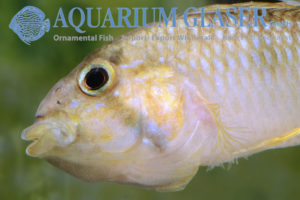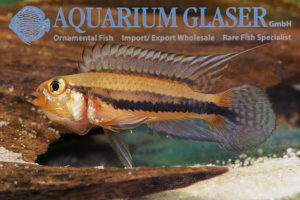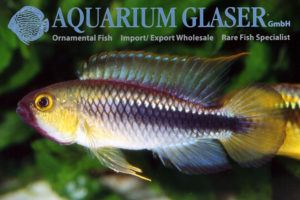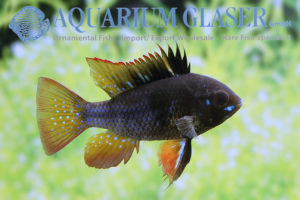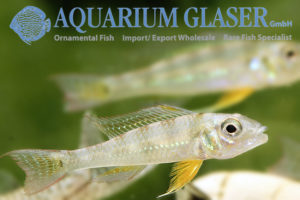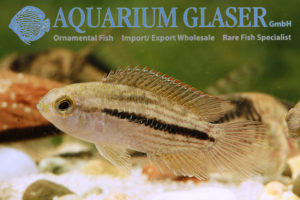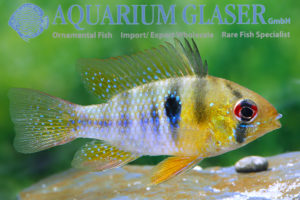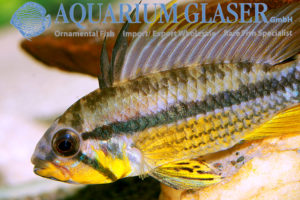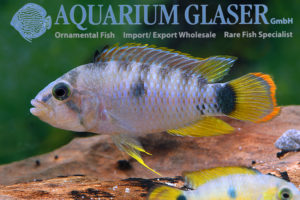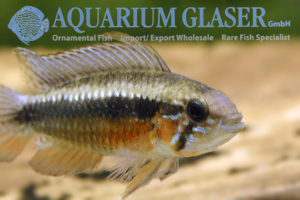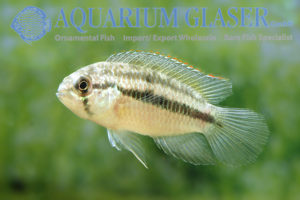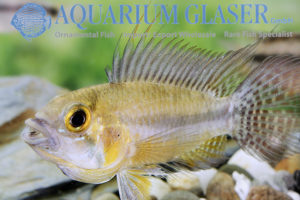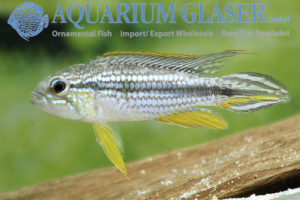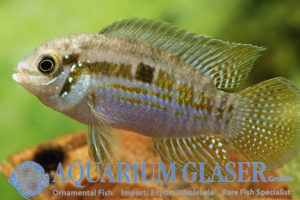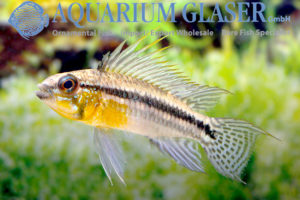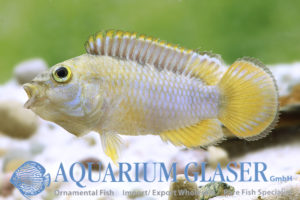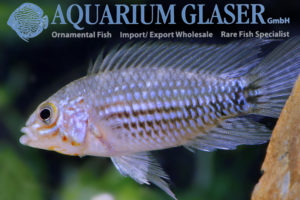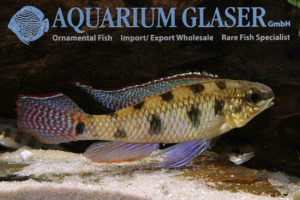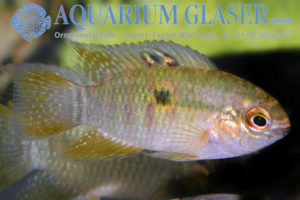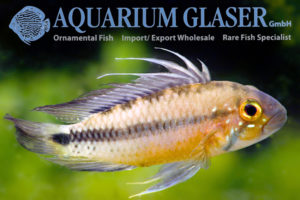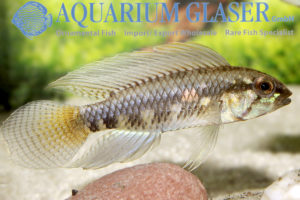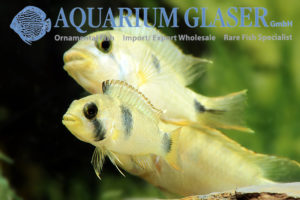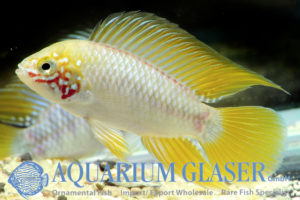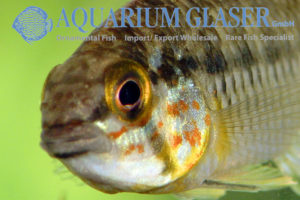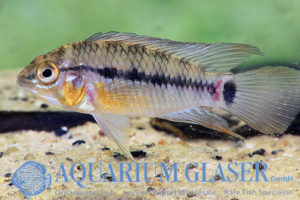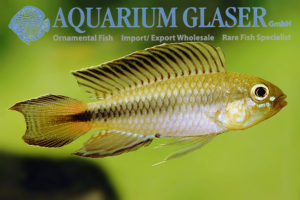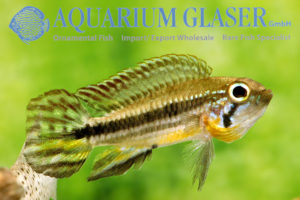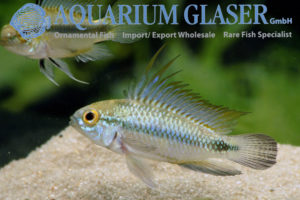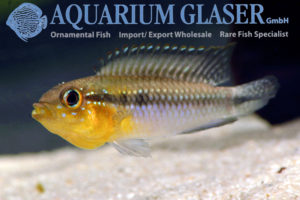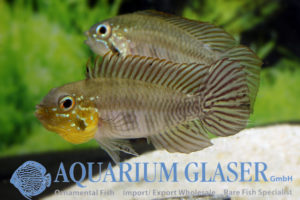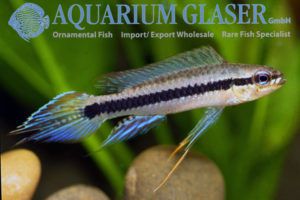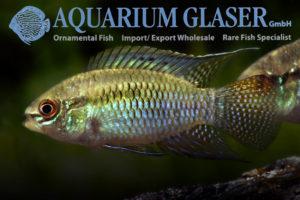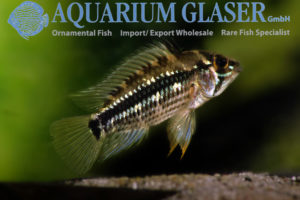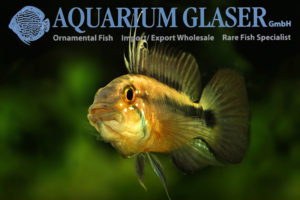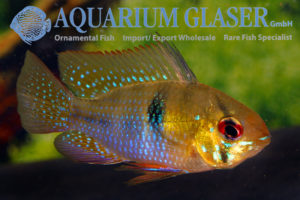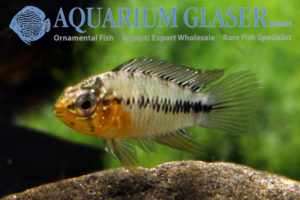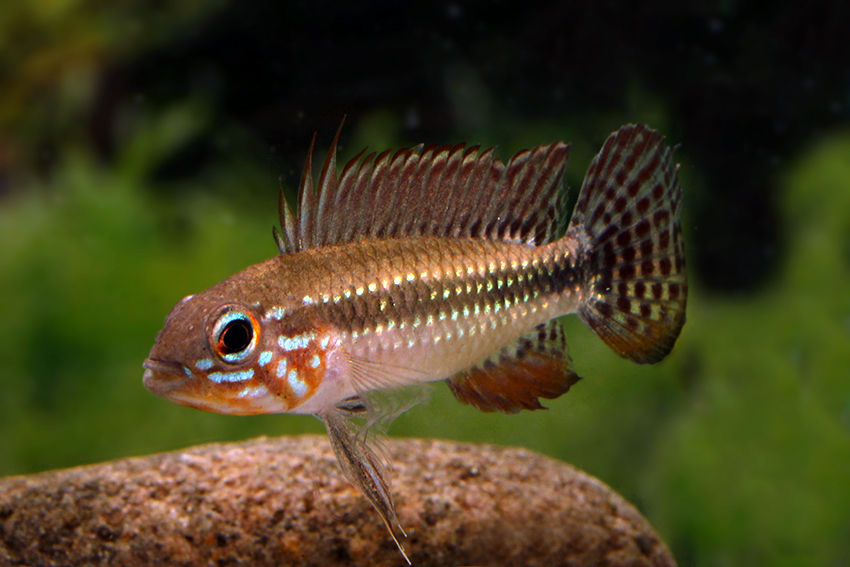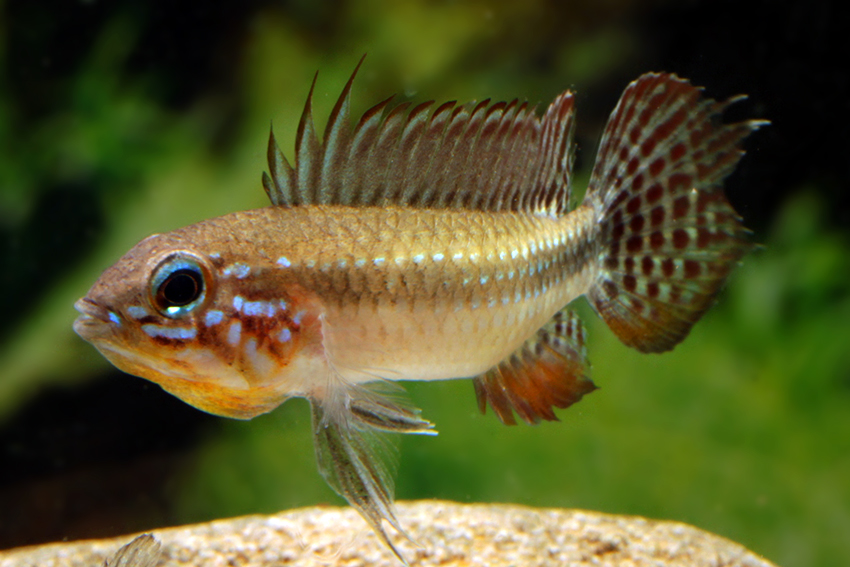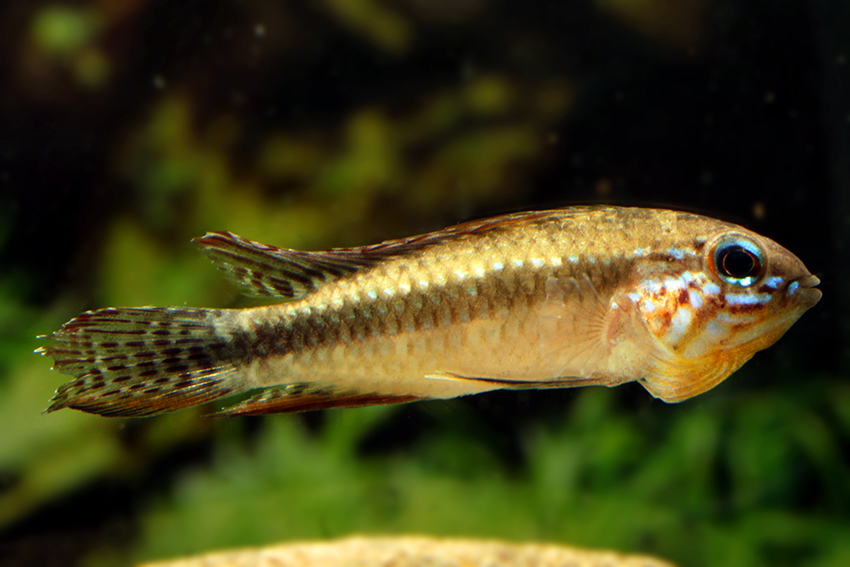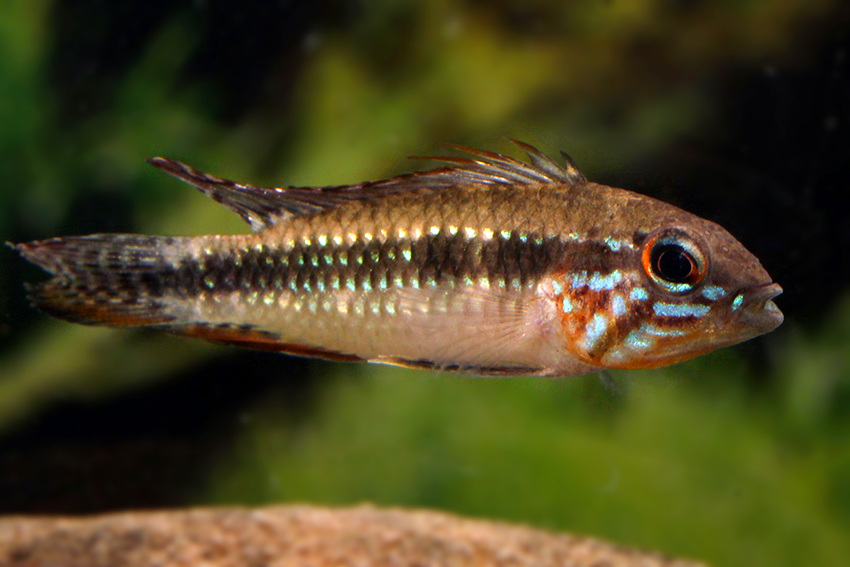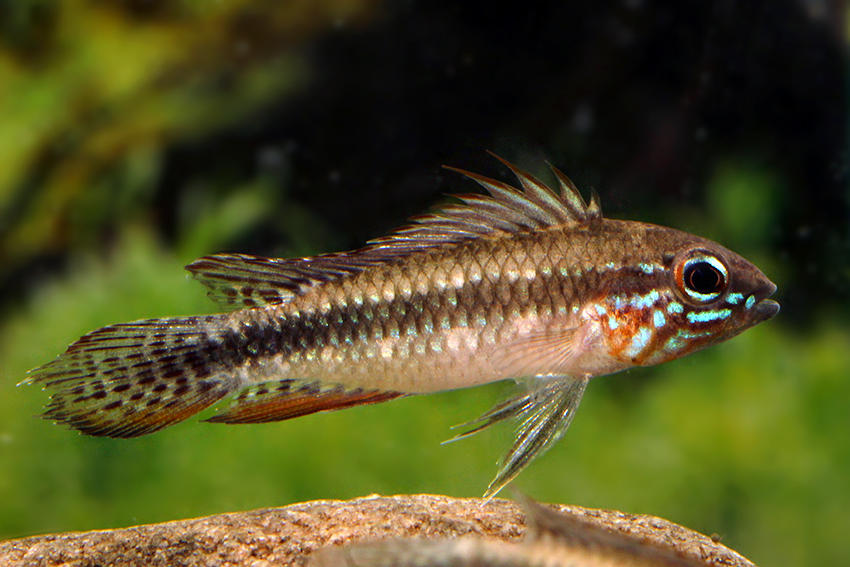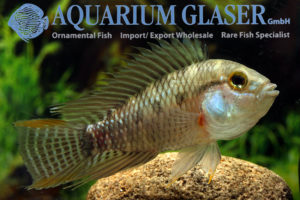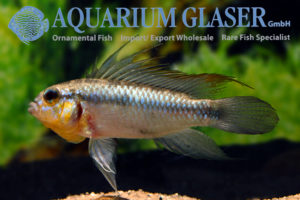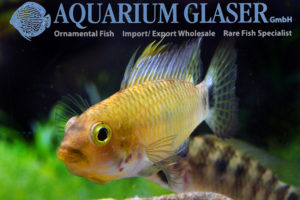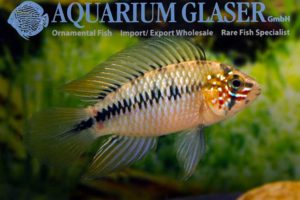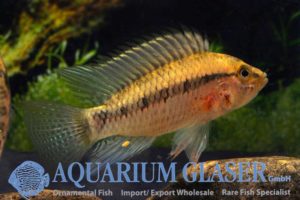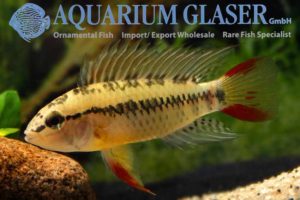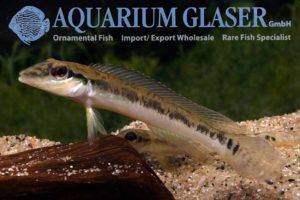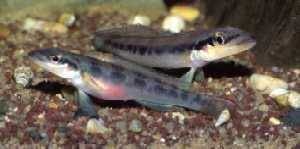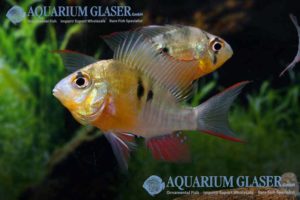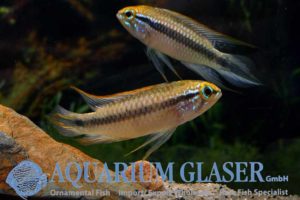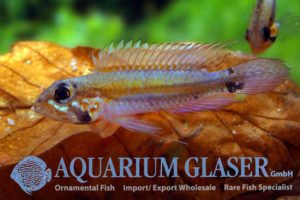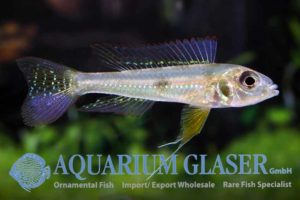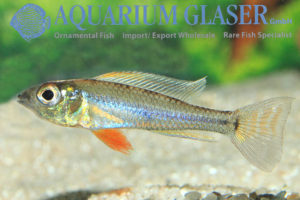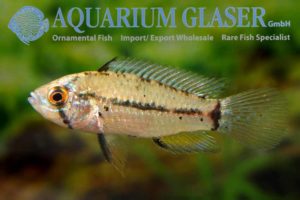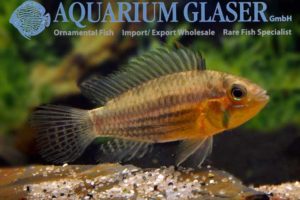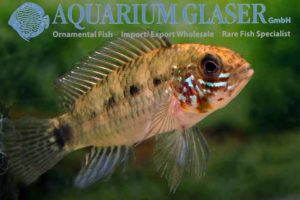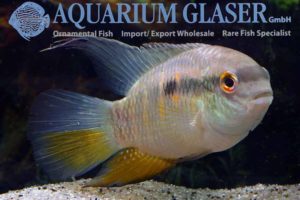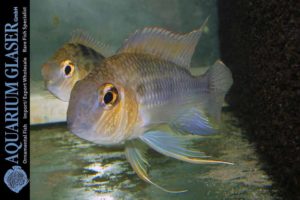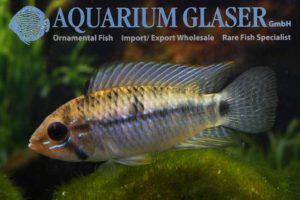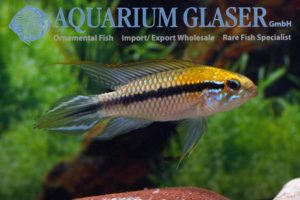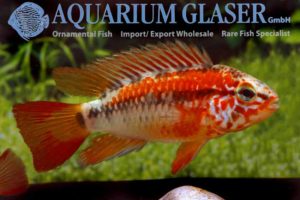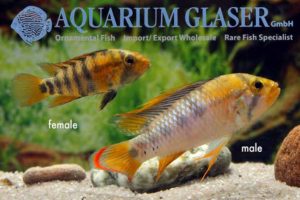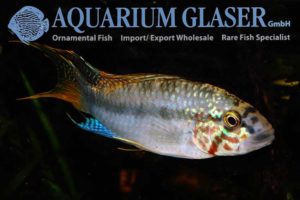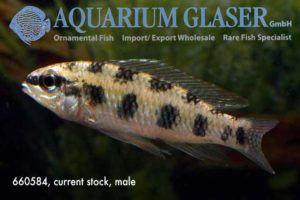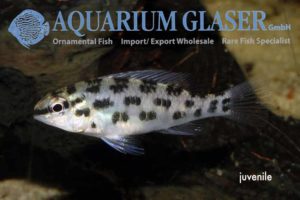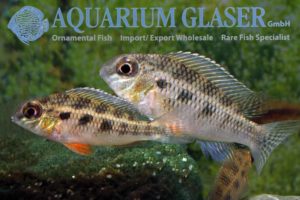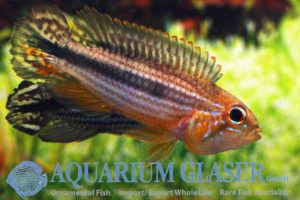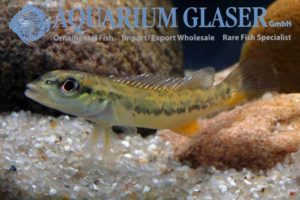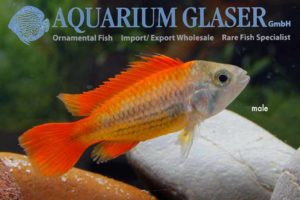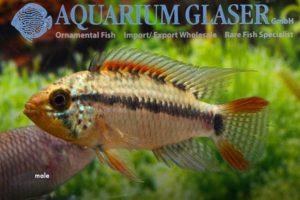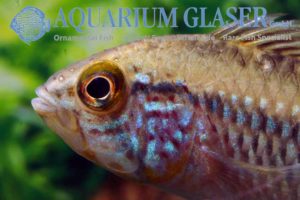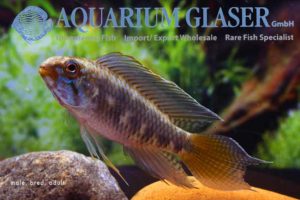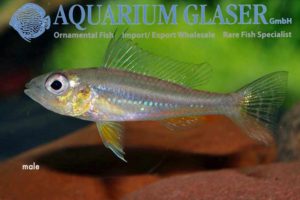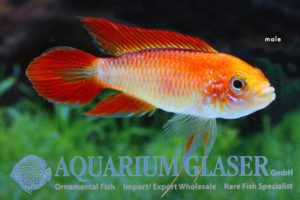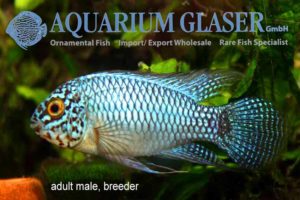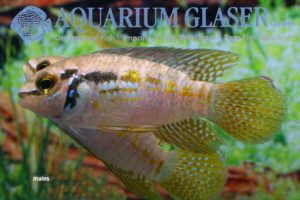We have already reported on Apistogramma bitaeniata several times, please see hhttps://www.aquariumglaser.de/en/25-perchlike-fishes/apistogramma-bitaenata-brazil/ or https://www.aquariumglaser.de/en/fisharchive/apistogramma-bitaeniata-putumayo-4/. This species is without doubt one of the most beautiful dwarf cichlids around. We have recently received a locality variant from Brazil that differs in color from the specimens we normally obtain from there. In the light of the torch, we […]
25d. Perchlike fishes (4): South American Dwarf Cichlids (138)
-
-
Apistogramma psammophila
The two-banded dwarf cichlid, Apistogramma diplotaenia, is one of the dream fish of many Apistogramma lovers. The species originates from the Rio Negro drainage in Brazil. Unfortunately, this fish is also one of the most demanding species of the genus and even minor carelessness – e.g. a missed water change and the resulting increase in […]
-
Apistogramma salpinction
In the 1980s, anyone interested in the dwarf cichlids of the genus Apistogramma did not need to know more than 10 species. Today (2025), this genus is the most species-rich cichlid genus of all, with 94 accepted species plus numerous species that have not yet been scientifically recorded. The majority of the newly discovered species […]
-
Apistogramma cacatuoides Yellow wild
The Cockatoo Dwarf Cichlid is one of the most popular members of the genus Apistogramma and found in petshops all over the World. Almost exclusively bred specimens of very colourful sports are traded. These do not appear in the wild. However, “the” wild form of A. cacatuoides does not exist at all. Like so many […]
-
Ivanacara adoketa ( = Nannacara a.)
This cichlid, which only occurs in a narrowly defined area on the middle Rio Negro and was only scientifically described as Nannacara adoketa in 1993, was for a long time one of the absolute dream fish of cichlid enthusiasts. The initially very few imported fish were mostly exported to Japan and insane prices were demanded […]
-
Apistogramma cacatuoides Double Red
Of course this beautiful breeding form of the cockatoo dwarf cichlid is not a novelty, but such beautiful specimens, as those, which we just received from a German breeder, are a rarity! For our customers: the animals have code 617803 on our stocklist. Please note that we only supply wholesalers. Text & photos: Frank Schäfer
-
Biotoecus dicentrarchus
The dwarf cichlids of the genus Biotoecus were shrouded in mystery for decades. The first species, B. opercularis, was scientifically described as early as 1875. It originated from the Amazon River basin in Brazil, a well-collected area for aquaristic purposes, and yet the first import was not accomplished until the mid-1980s and early 1990s. The […]
-
Apistogramma gephyra Santa Isabel
Since its scientific description in 1980, this dwarf cichlid has been the subject of heated debate among enthusiasts. Some consider it to be another color variant of Apistogramma agassizii, while others are certain that it is a separate species. Both parties are probably right; there is no doubt that Apistogramma gephyra and A. agassizii are […]
-
Apistogramma bitaeniata “Putumayo”
Apistogramma bitaeniata is already one of the most beautiful Apistogramma species of all, but the local variant from the Rio Putumayo in Peru goes one better. The males with their huge fins are truly breathtaking. The females look almost underdeveloped in comparison. And yet all this splendor serves only to impress the delicate sex… The […]
-
Apistogrammoides pucallpaensis
The dwarf among the little ones: Apistogrammoides pucallpaensis from the upper Amazon in Colombia and the Rio Ucayali in Peru is one of the smallest cichlid species of all. We obtain our animals from Peru. In the literature, the maximum sizes given are 5 cm for males and 4 cm for females. However, these must […]
-
Nannacara anomala
Here’s another animal from the “been in the aquarium forever but still beautiful” department! Nannacara anomala, the Golden Dwarf Cichlid from Guyana, has already delighted our grandfathers. We currently have exorbitantly colored animals in stock, which we call “Red”. They come from a breeder who has really put a lot of love and ambition into […]
-
Apistogramma norberti
The 1990s were a decade in which many new dwarf cichlid species were discovered and scientifically described. This was made possible by the combination of good travel opportunities and tolerant export policies, the emerging Internet and the resulting considerably simplified global communication. Apistogramma noberti, a species from Peru that was scientifically described in 1991, was […]
-
Apistogramma sp. Nanay
The species characteristics of this dwarf cichlid from Peru are: distinct underbelly stripes, an orange “axillary spot” (the attachment point of the pectoral fin is intensely orange in color), a more or less distinct orange zone on the belly and a tail fin that is tipped at the top and bottom in old, fully developed […]
-
Dicrossus warzeli Bred
The rarest of all checkerboard cichlids in the aquarium is Dicrossus warzeli, which was known as Dicrossus or Crenicara sp. Tapajós before its scientific description. In 1992 the very characteristically marked dwarf cichlid was discovered in an unnamed tributary (Igarapé) of the great Rio Tapajós in Brazil by the traveling aquarist Frank Warzel and brought […]
-
Laetacara curviceps
Long before the Apistogramma species became popular, another dwarf cichlid from Brazil captured the hearts of aquarists: Laetacara curviceps, the Flag acara. At that time it was still called Aequidens curviceps. For some time it has unfortunately become quiet around him. Now we have once again received beautiful offspring of this small, peaceful and beautiful […]
-
Wallaciia compressiceps (= Crenicichla c.).
The dwarf spezies among the pike cichlids have recently been separated as an independent genus Wallaciia (see https://www.aquariumglaser.de/en/fish-archives/the-crenicichla-have-been-reclassified/). They include W. compressiceps, which occurs only in the Tocantins and Araguaia rivers in Brazil. It is one of the smallest, the prettiest and the most aggressive pike cichlid species. Although it only grows to a maximum […]
-
Apistogramma allpahuayo (2)
From Peru a beautiful dwarf cichlid regularly comes to us, which is called “Apistogramma juruensis” on the exporter´s lists. The animals are very similar to A. cacatuoides and to A. juruensis, but can usually be easily distinguished from both by one coloration feature: a black chin spot, which was decisive for the common trade name […]
-
Apistogramma kullanderi
The “Giant Apistogramma” caused a flurry of excitement when it was discovered in 2009 during an expedition to the Serra do Cachimbo (Pará, Brazil). The discoverers, J. L. O. Birindelli and M. Sabaj Perez, reported on this great fish in various journals, initially under the name A. sp. “Gigas”. Then in 2014, Varella and Sabaj […]
-
Apistogramma psammophila
The two-banded dwarf cichlid, Apistogramma diplotaenia, is one of the dream fish of many Apistogramma lovers. The species originates from the Rio Negro drainage in Brazil. Unfortunately, this fish is also one of the most demanding species of the genus and even minor carelessness – e.g. a missed water change and the resulting increase in […]
-
Apistogramma sp. Amaya
New catch areas bring immediately new species! That these are also wonderfully colored animals, as in the case of the bright red Nannostomus or the Apistogramma sp. Amaya (also called A. sp. Cenepa II) presented here, is surprising. Because Peru is really well collected! But let’s not be surprised, but enjoy the beautiful new imports! […]
-
Apistogramma panduro
In Apistogramma panduro from Peru (drainage of the Rio Ucayali, east of Jenaro Herrera) the females are absolutely emaciated. They are at least as beautiful as the males, if not more so; they fight as if they were males, and they show marked polychromatism. Polychromatism, or multicolorism, is when animals are individually, not species-specifically, differently […]
-
Dicrossus filamentosus
The checkerboard cichlid (Dicrossus filamentosus) is the most typical dwarf cichlid in the habitat of the cardinal tetra (Paracheirodon axelrodi). It is found in Brazil (Rio Negro drainage) as well as in Colombia and Venezuela (Orinoco drainage). Males have a lyre-shaped caudal fin and grow to almost 8 cm long; the caudal fin of females […]
-
Apistogramma agassizii Peru wild
The dwarf cichlid Apistogramma agassizii has a distribution area that extends through practically the entire Amazon. With many of its genus comrades it is completely different, they often occur only locally and form then also location variants. Agassiz’ dwarf cichlid has so far successfully resisted all attempts to divide it. It is true that some […]
-
Apistogramma barlowi (= sp. mouthbrooder)
The first reports about the brood care behavior of this dwarf cichlid in the early 2000s were a sensation. Mouthbrooding Apistogramma – one had never heard of it before. Later it turned out that things are complicated. Some of the females of A. barlowi, as this species is now called, show quite normal Apistogramma brood […]
-
Apistogramma diplotaenia German bred
The double stripe (= the translation of the word diplotaenia) is still a rare occurrence in the aquarium. For successful breeding you have to reach pretty deep into the bag of tricks of water chemistry and the animals are also relatively unproductive. This unusual Apistogramma species originates from the black water of the Rio Negro, […]
-
Apistogramma sp. Wilhelmi
More than 20 years ago (1999) Mario Wilhelm brought back from an expedition to Brazil for the first time this beautiful dwarf cichlid from the Rio Abacaxis. An alternative name to Apistogramma sp. Wilhelmi is therefore A. sp. Abacaxis. This river, a well known area for discus fishes, belongs to the drainage of the Rio […]
-
Mikrogeophagus ramirezi “Black”
Black butterfly cichlids have been around for a few years and many breeders do an excellent job on them, so that really beautiful and healthy animals come on the market. We have now received a strain of Black Rams, in which the blue of the scales is limited to the rear half of the body […]
-
Biotoecus dicentrarchus
The dwarf cichlids of the genus Biotoecus were shrouded in mystery for decades. The first species, B. opercularis, was scientifically described as early as 1875. It originated from the Amazon River basin in Brazil, a well-collected area for aquaristic purposes, and yet the first import was not accomplished until the mid-1980s and early 1990s. The […]
-
Nannacara taenia
Nannacara taenia is with a maximum of 5 cm total length one of the smallest cichlids at all. Additionally it is absolutely peaceful and therefore an ideal fish for community aquariums. The species was described in 1911 from aquarium fishes believed to have been exported via Manaus. However, these animals were never found again in […]
-
Mikrogeophagus ramirezi wild
Because of the enormous popularity of the butterfly cichlid or blue ram (Mikrogeophagus ramirezi), there are mainly offspring and breeding forms on the market. Also the wild-colored offsprings differ clearly from the wild species: they are considerably larger (4-5 cm body length without caudal fin compared to 2-3 cm with wild-caught fish) and at the […]
-
Apistogramma allpahuayo
For a long time this beautiful dwarf cichlid from the basin of the Rio Nanay in Peru sailed under the name “cf. juruensis” or “sp. Black Chin”. Only the scientific description of the species in 2012 put an end to the confusion. Great similarity exists to A. juruensis and A. cacatuoides. From both species living […]
-
Apistogramma sp. Oregon
The attractive Apistogramma sp. Oregon comes from the wider surroundings of Iquitos in Peru. Don’t ask us why this one is called “Oregon” – we don’t know that either. It belongs to the closer relationship of A. nijsseni, but differs clearly from this species by the bulky body structure, the large tail spot and a […]
-
Apistogramma elizabethae
This wonderful dwarf cichlid belongs to the rarest and most wanted species of Apistogramma in the trade. Nevertheless the animals are not very difficult to keep at all. If the fish is kept under the correct conditions it belongs to the hardier species of the genus. There do exist elder reports on the fish that […]
-
Nannacara sp. “Crique Canceler”
The Goldeneye cichlid (Nannacara anomala) is a classic among aquarium fish. Already 80 years ago this species taught the aquarists what emancipation means, because here the female is the absolutely dominant fish. And the female often is only half as big as the maximum 8 cm long male. Dwarf cichlids from the closer relationship of […]
-
Apistogramma cacatuoides Yellow wild
The Cockatoo Dwarf Cichlid is one of the most popular members of the genus Apistogramma and found in petshops all over the World. Almost exclusively bred specimens of very colourful sports are traded. These do not appear in the wild. However, “the” wild form of A. cacatuoides does not exist at all. Like so many […]
-
Apistogramma agassizii „Tefé“
There are many colour varieties of Apistigramma agassizii. The species – as it is currently understood – occurs in the complete Amazon river area in Colombia, Peru, and Brazil. The most wanted variety is probably the „Tefé“ variety. It is, however, not really proven that this variety really comes from the Rio Tefé, a right […]
-
Laetacara araguaiae
Finally we were able to import once more this charming dwarf cichlid. The fish was known in the hobby under the name of Laetacara sp. “Buckelkopf” ( = humphead) before the scientific description. For more informations, please click https://www.aquariumglaser.de/en/fish-archives/laetacara_araguaiae_en/ For our customers: the animals have code 603002 on our stocklist. Please note that we exclusively […]
-
Apistogramma bitaenata Brazil
Apistogramma bitaenata is one of the most beautiful species of the genus. And it is known for a very long time in the hobby already. Elder hobbyists will know the species maybe under the name of A. kleei, other, well known synonymys are A. klausewitzi and A. sweglesi. The species has a very wide distribution […]
-
Apistogramma nijsseni
The Panda Dwarf Cichlid (Apistogramma nijsseni) was an absolute sensation when it was first introduced at the end of the 1970s. The breeding was successful right away, but it took several years before it was understood that the – often extreme – male surplus observed in the offspring came from too high water temperatures during […]
-
Apistogramma rubrolineata
The Bolivian dwarf cichlid Apistogramma rubrolineata is one of the true rarities in the trade. The species was only discovered in 2001 and scientifically described in 2002. The scientific name of the species refers to the seven brown-red longitudinal stripes that this species has. However, they are to be seen in full expression only in […]
-
Dicrossus maculatus xxl German Bred
The checkerboard dwarf cichlids (Dicrossus) belong to the most beautiful of all dwarf cichlids. However, they are very demanding concerning the chemical water composition, at least when it comes to breeding. Then they need almost distilled water with a pH value around 5. Any bacterial load is only poorly tolerated. For this reason, Dicrossus are […]
-
Laetacara dorsigera Wild
Finally, after several years, we received again beautiful wild collected specimens of this charming dwarf cichlid from Paraguay. Males become around 8 cm, females about 6 cm long. The species is very pretty even in “normal” mood, but when they come in breeding condition they get a lilac colored throat that makes them even more […]
-
Apistogramma atahualpa
Before its scientific description this beautiful species of dwarf cichlid from Peru was known in the hobby as the „Sunset-Apistogramma“. And in fact the body coloration of a female during brood care reminds one in a sunset. The scientific name, atahualpa, refers to the last great ruler of the Inka empire: Atahualpa. He was captured […]
-
Apistogramma iniridae
Sadly this beautiful dwarf cichlid is only occasionally available, but currently we were able to import once more beautiful, fully grown specimens. The fish display all the behaviour that makes the keeping of these fish so desirable. Like its close relative A. uaupesi, which differs from A. iniridae mainly due to the lyra-shaped caudal fin […]
-
Apistogramma pantalone
Two species of so-called Lyratail-Apistogramma come from Peru, which are very similar to each other: A. martini and A. pantalone. Both are among the most delicate and difficult Apistogramma species ever, but this is not a law of nature, but depends on circumstances in nature that have not yet been understood. At the beginning of […]
-
Apistogramma borellii “Opal”
We have received from a German breeder wonderful, fully grown Apistogramma borellii in two selections, “Opal” with red pattern on the head and “Reitzigi” with bright yellow head. With both forms, the males have dorsal fins of almost body height – fantastic animals! All photos of this post show animals of the “Opal”-form. For general […]
-
Apistogramma cf. taeniata
Nobody knows exactly what Apistogramma taeniata is, because the species was described in 1862 after a specimen, which is today in a very bad condition and the verbal description is more than scarce. At the time of the description, the genus Apistogramma did not yet exist, no one had any idea of its variety of […]
-
Apistogramma regani
This dwarf cichlid was scientifically described in 1980, long before it was recognized how enormously species-rich the genus Apistogramma is. The exact determination of this species is correspondingly tricky. It is essentially based on the pronounced zebra crossing, which the animals show above all when they are worried. The species is little known in the […]
-
Apistogramma uaupesi
Apistogramma uaupesi is certainly one of the most beautiful dwarf cichlids. Adult males can be very variable colored, therefore A. uaupesi got several German popular names, like “Rotkeil-Apistogramma” or “Blutkehl-Apistogramma” (= Red Wedge and Blood Throat). In nature, however, all color variants occur together, so it is not a matter of locality forms, but of […]
-
Apistogramma mendezi Santa Isabel
Apistogramma mendezi belongs without any doubt to the most attractive members of the genus, but the animals we currently obtained from around Santa Isabel are even more attractive than usual. Of course the males of that population are as polychromatic as all Apistogramma males are, which means that hardly two males are looking identical, but […]
-
Apistogramma trifasciata
In case this dwarf cichlid would not exist it would be necessary to invent it for the aquarium hobby. Apistogramma trifasciata is an ideal aquarium inhabitant. The species stays small – males around 5 cm, females around 4 cm. It is completely undemanding regarding water chemistry – keeping and breeding is possible even in medium […]
-
Apistogramma gephyra wild
Since its scientific description in 1980 this dwarf cichlid is subject of an ongoing debate among keepers and breeders of Apistogramma. Some think that A. gephyra is a mere variety of A. agassizii, others defend its status quo as a separate species. Most likely both parties are right. There can be no doubt that A. […]
-
Apistogramma gibbiceps
Currently we received once more this pretty dwarf cichlid from the Ro Negro basin. It is a typical company of the cardinal tetra in the wild. The species Apistogramma gibbceps cannot be confused with any other species of Apistogramma when it shows the species-specific vertical bars on the belly. Sadly these bars are not visible […]
-
Taeniacara candidi
This dwarf cichlid from Brazil is a very pretty species. Currently we have charming wild collected specimens in a good number in stock. Principically speaking Taeniacara – there is only one known species, T. candidi – is a very elongated Apistogramma. So the aquarium biology is quite comparable in both genera. That means the fish […]
-
Laetacara curviceps
Quite a long time before the species of Apistogramma became popular in the hobby, another species of dwarf cichlid from Brazil was a favorite aquarium fish: Laetacara curviceps, the flag acara. At these times it was called Aequidens curviceps. Sadly the fish became rather rare in the past years. So we are glad that we […]
-
Apistogramma sp. Marandu
We received from Peru for the very first time this new, interesting and beautiful species of Apistogramma; sadly no further information on the origin is available. As the new fish cannot be applied for sure to an already described species, we simply adopted the name the exporter gave to the fish. Marandu belongs to the […]
-
Apistogramma atahualpa
Before its scientific description this beautiful species of dwarf cichlid was known in the hobby as the „Sunset-Apistogramma“. And in fact the body coloration of a female during brood care reminds one in a sunset. The scientific name, atahualpa, refers to the last great ruler of the Inka empire: Atahualpa. He was captured by the […]
-
Wild Rams
Due to the regularly offered, amazing bred sports of the Ram (Mikrogeophagus ramirezi) one tends to forget, how breathtaking beautiful the wild collected fish is already. Currently we have fully grown, wild collected Rams from Venezuela in stock. By the way: wild collected Rams become only about 5 cm long (in males), females even stay […]
-
Apistogramma borellii Paraguay wild
Recently we received beautiful wild collected specimens of A. borellii from Paraguay. This species is an ideal aquarium fish. In contrast to many other species of the genus A. borellii is completely undemanding regarding water chemistry. Even in medium hard, slightly alcalic water the species thrives well and even breeds. The behaviour of A. borelli […]
-
Apistogramma eunotus „Rio Tapiche“
Apistogramma eunotus is among the species of Apistogramma with the deepest body of all. The species can be told apart from other, similar species, best by the large blueish spot on the opercle. We obtained recently very different specimens of A. eunotus from the Rio Tapiche in Peru. They differ in many respects from typical […]
-
Apistogramma trifasciata „Rio San Martin“
We received very nice German bred specimens of that dwarf cichlid. The specimens are descendants of the yellow-headed population that has been initially collected by the well known dwarf cichlid specialist and ichthyologist Dr. Wolfgang Steack in the Rio San Martin (Rio Guapore basin). He portrayed that population in detail in the DCG Sonderheft 2008 […]
-
Apistogramma personata Mitu
The identity of this dwarf cichlid – it belongs to the absolute top-rarities – is under discussion. It is a fact hat it has been collected for the first time in 1995 by Uwe Werner and company near Mitu, Colombia. The city of Mitu is placed at the banks of the Rio Vaupes. Uwe was […]
-
Apistogramma borellii WILD
We received beautiful, wild collected specimens of this dwarf cichlid from Paraguay. The species belongs to the members of the genus Apistogramma that are kept and bred in aquaria for decades already. The splendid males become almost double as large as the females. The peaceful and pretty species can be kept during the summer months […]
-
Apistogramma sp. Nanay
When we unpacked these large, fully grown Apistigramma from Peru we thought initially: wow, that kind of Apistogramma was never here before! The species-specific features of the fish are: stripes on the underside of the belly, an orange colored spot on the basis of the pecoral fin, a more or less clearly recognizeable orange zone […]
-
Apistogramma macmasteri Tame
It was back in 1996 when Uwe Werner presented in the Aqualog South American Cichlids II a dwarf cichlid under this name. The city and municipality of Tame are located in Colombia in the Arauca Department at the Rio Arauca. Here the unusual Apistogramma macmasteri have been collected. Sadly it became soon after lost for […]
-
Teleocichla centrarchus
Teleocichla are small cichlids from Brazil. They love comparatively strong current. The genus is a close relative of the pike cichlids (Crenicichla). The genus teleocichla has been discovered only late, in 1988; currently 18 different species are known, 10 of them are still undescribed scientifically. Genus type is T. centrachus; we can offer now once […]
-
Teleocichla centrarchus
Teleocichla centrachus from Rio Xingu probably is the most imported Teleocichla. In addition, it is the type species of this kind. As the males have a maximum length of approx. 10cm, you can certainly still call them dwarf cichlids. The females, being mostly only 8cm maximum, are a little smaller and rather soon show a […]
-
Mikrogeophagus altispinosus
The Bolivian Ram, Mikrogeophagus altispinosus, is by far less popular than its well known cousin from Venezuela, the Common Ram (M. ramirezi). Maybe this is due to the fact that the Bolivian is traded almost exclusively as bred ones, because there are no commercial exports from the area where the species occurs naturally? But the […]
-
Apistogramma agassizii Tefé II and A. geisleri
We received very nice wild ciollected specimens of this variety of A. agassizii. One must not confuse these fish with the variety known as “Tefé I” (see http://www.aquariumglaser.de/en/fish-archive/dwarfcichlids-en/Apistogramma_agassizii_Tefe_en/), which is distinguished from all other varieties of A. agassizii by the additional rows of zigzag-bands on the belly. The variety “Tefé II” is characterized by a […]
-
Apistogramma diplotaenia
This dwarf cichlid is one of the most unusual members of the large genus Apistogramma. The very slim animals have a pattern of two longitudinal stripes. This is unique among Apistogramma and makes A. diplotaenia unmistakable. Sadly this species is offered only very rarely. Currently we have both wild collected fish (see photos) and bred […]
-
Biotoecus opercularis
We received beautiful, fully grown wild collected Biotoecus opercularis from Brazil. Formerly these sandhill-builders (see http://www.aquariumglaser.de/en/fish-archive/dwarfcichlids-en/biotoecus-opercularis-3/) were said to be extremely demanding and difficult to keep. Our recent imports, however, are very, very stout and healthy animals! For our customers: the fish have code 634493 on our stocklist. Please note that we exclusively supply the […]
-
Biotoecus opercularis
This fish probably represents the most interesting species of dwarf cichlids from Amazonia. Currently we were able to import it once more. B.opercularis is for sure not demanded due to its coloration. As typical sand cichlids they do not have pop-art colours, but shining pastel shades. The same phenomenon can be found in the sand […]
-
Apistogrammoides pucallpaensis
Among the dwarfs this is the smallest: Apistogrammoides pucallpaensis. This species from Peru is one of the smallest species of cichlid at all. The maximum size is given in literature with 5 cm (males) and 4 cm (females). However, this must refer to very old aquarium specimens. Wild collected ones are mature and fully grown […]
-
Apistogramma cacatuoides wild
The Cockatoo Dwarf Cichlid is one of the most popular members of the genus Apistogramma and found in petshops all over the World. Almost exclusively bred specimens of very colourful sports are traded. These do not appear in the wild. However, “the” wild form of A. cacatuoides does not exist at all. Like so many […]
-
Apistogramma commbrae
The species Apistogramma commbrae is only very occasionally available. The species has been described back in 1906 already and has a very wide distribution: Argentina, Brazil, and Paraguay. But from this region mainly the close relatives of A. commbrae, namely A. borellii and A. trifasciata become exported. This is not easy to understand, because A. […]
-
Laetacara fulvipinnis
Only very rarely this beautiful dwarf cichlid becomes imported. Nevertheless it is known in the hobby for quite a long time. Since 1978 it was named “Aequidens sp. Orange Fin”, later, after the splitting of Aequidens and Laetacara in separate genera, Laetacara sp. “Orange Fin”. The scientifical valid description appeared only in 2007, when Staeck […]
-
Crenicara cf. punctulatum Lake Tapana
It was only quite recently that we were able to import Crenicara puntulatum from Peru. We reported on that importation here: http://www.aquariumglaser.de/en/news/Crenicara_punctulatum_Checkerboard_cichlids_part_1_en/. Now we received fully grown specimens from Brazil with an information on the collection site: Lake Tapana. These fish differ in some points from all so far described populations of Crenicara punctulatum. The […]
-
Apistogramma rupununi
Finally we were able to import again this dwarf cichlid after quite a long time. Most probably our specimens originate from Amapá in Brazil. It is quite tricky to distinguish A. rupununi from A. steindachneri in small wild collected specimens. However, our recently imported fish are quite large already (some males are already about 5 […]
-
Apistogramma gephyra Bred
Do you know the difference between Apistogramma gephyra and A. agassizii? No? Well, you are in good company with that! Both species are really difficult to tell apart. They also appear at least in some places together in the natural habitat, so the origin is of no help. Both species never hybridize in the wild. […]
-
Apistogramma viejita Variety II
Apistogramma viejita originates from Colombia. However, in the ornamental fish trade almost exclusively bred specimens can be found. There do exist several varieties even in the wild, which differ mainly in coloration (especially the content of red is very different), but also in respect of the development of the dorsal and caudal fins. Sadly the […]
-
Apistogramma baenschi (= Inka I)
Apistogramma baenschi from Peru is for sure among the most beautiful species of dwarf cichlid. The male combines splendid colours (especially the wonderful caudal fin) with a fantastic high dorsal fin and the female is also a real eyecatcher due to its unique tiger pattern. Currently we have both wild collected and bred specimens in […]
-
Apistogramma sp. Diamond Face
We received some German bred specimens of that rare Apistogramma from one of our breeders currently. Initially this fish was imported in 2009 It was said to originate from the Rio Jutai in Brazil, a left hand affluent to the Amazon river (which is called Solimoes there). Since then to the best of our knowledge […]
-
Dicrossus maculatus – Checkerboard cichlids part 3
This splendid dwarf cichlid is known to science since 1875, but almost never found in home aquaria. This is a great pity, because there are hardly any species that are as beautiful as this one and simultaneously as peaceful! Males become around 9 cm long, females about 6 cm. The animals we currently have in […]
-
Dicrossus foirni (= sp. Rio Negro): checkerboard cichlids, part 2
Finally Dicrossus foirni is available again! This extremely rarely imported dwarf cichlid was formerly known in the hobby under the name of Dicrossus sp. “Rio Negro”. These fish are a real eyecatcher when fully grown. Keeping this jewel is not complicated at all, but for breeding extreme water conditions are necessary (pH below 5, hardness […]
-
Crenicara punctulatum – Checkerboard cichlids, part 1
Currently we have several species of checkerboard cichlids (genera Crenicara and Dicrossus) in stock. Most of them are real rarities in the hobby, among them Crenicara punctulatum. We obtained this pretty species from Peru. Males of Crenicara punctulatum can attain a maximum length of about 12 cm, so this species is not a dwarf cichlid […]
-
Apistogramma agassizii Tefé
We received extremely beautiful wild collect specimens of this most desirable variety of Apistogramma agassizii. The fish show the stripes on the belly, which are so characteristic for the Tefé-variety and additionally they have the yellowish-reddish back of the Santarém-variety. Gorgeous! For our customers: the fish have code 614772 on our stocklist. Please note that […]
-
Teleocichla proselytus
We received this very rarely offered dwarf cichlid from the Rio Tapajós in Brazil. Like in the humphead cichlids of the genus Steatocranus in Africa, Teleocichla have a reduced swimming bladder; because of that they exclusively live near the bottom. Our specimens have very nice orange colours in the fins. For our customers: the fish […]
-
Apistogramma cacatuoides Mega Orange
An orange sport of the cockatoo dwarf cichlid is already known for quite a long time. But now we received for the first time a new strain that has really wonderful orange coloration. The breeder calls it “Mega Orange” – and we agree! For our customers: the fish have code 617343 on our stocklist. Please […]
-
Apistogramma sp. Xingu / Vielfleck
We received wonderful, fully grown bred specimens of this beautiful dwarf cichlid. The species is still undescribed scientifically. For our customers: the animals have code 628744 on our stocklist. Please note that we exclusively supply the wholesale trade. Text & photos: Frank Schäfer
-
Apistogramma urteagai
This pretty dwarf cichlid from the Madre de Dios region in Peru is offered only very occasionally. The species is quite undemanding and thus a perfect subject for beginners who want to collect first experiences in keeping and breeding dwarf cichlids. A. urteagai does not require any special water conditions, this is another advantage of […]
-
Apistogramma uaupesi
This is without any doubts one of the most attractive dwarf cichlids. Fully grown males show a very variable coloration, a fact that led to different common names in the past, like “Rotkeil-Apistogramma” (which means “Red-Wedge-Apistogramma”) or “Blutkehl-Apistogramma” (which means “Blood-Throat-Apistogramma”). However, according to most current knowledge, all these varieties appear in the wild together […]
-
Biotoecus dicentrarchus
We have very nice, healthy specimens of this extremely rare dwarf cichlid from Venezuela in stock. For more information, please see http://www.aquariumglaser.de/en/news/Biotoecus_special_en/ For our customers: the fish have code 634483 on our stocklist. Please note that we exclusively supply the wholesale trade. Available in very limited numbers only! Text & photos: Frank Schäfer
-
Apistogramma agassizii Super Fire Red
We received extraordinary beautiful specimens of this sport. Available in limited numbers only! For our customers: the animals have code 614883 on our stocklist. Please note that we exclusively supply the wholesale trade. Text & photos: Frank Schäfer
-
Apistogramma sp. STEEL BLUE
We received German bred ones of this magnificent Apistogramma. Very colorful! For our customers: the fish have code 628613 on our stocklist. Please note that we exclusively supply the wholesale trade. Text: Frank Schäfer, photos: Frank Schäfer, Rainer Hoyer
-
Laetacara araguaiae
Finally we were able to import once more this charming dwarf cichlid. The fish was known in the hobby under the name of Laetacara sp. “Buckelkopf” ( = humphead) before the scientific description. For more informations, please click http://www.aquariumglaser.de/en/news/Laetacara_araguaiae_en/ For our customers: the animals have code 603002 on our stocklist. Please note that we exclusively […]
Apistogramma eremnopyge
When this beautiful Apistogramma first arrived in January 2003, we were thrilled. At that time we wrote:
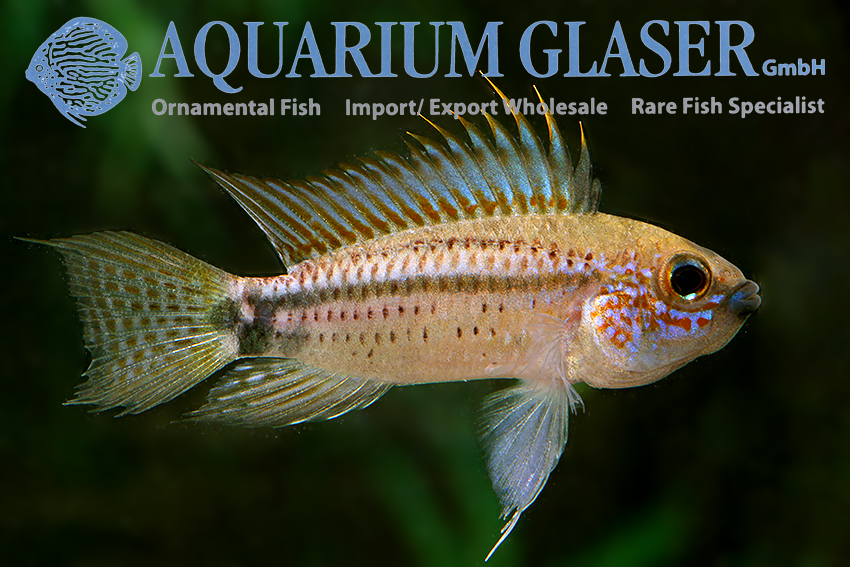
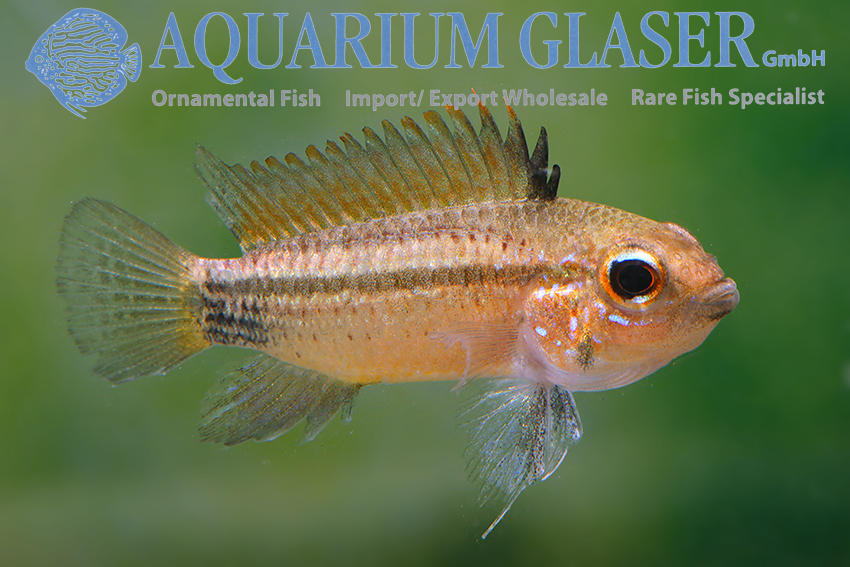
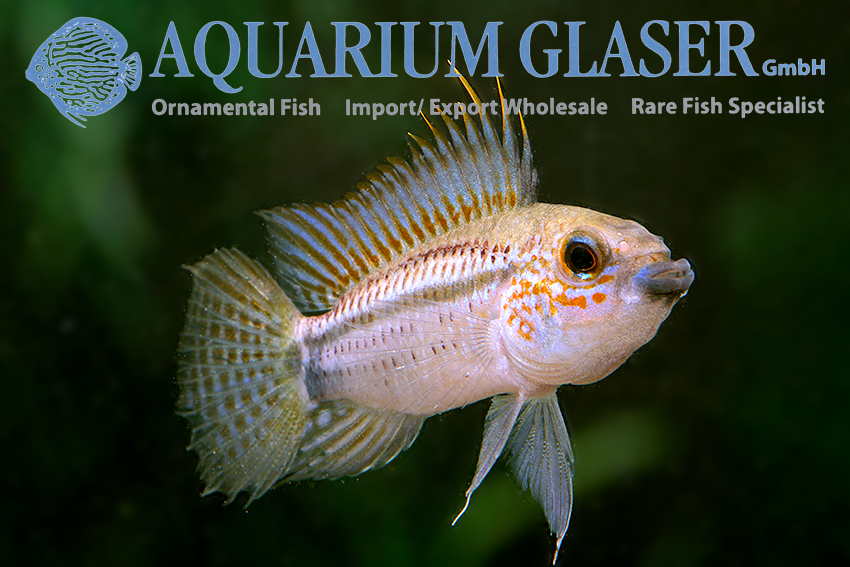
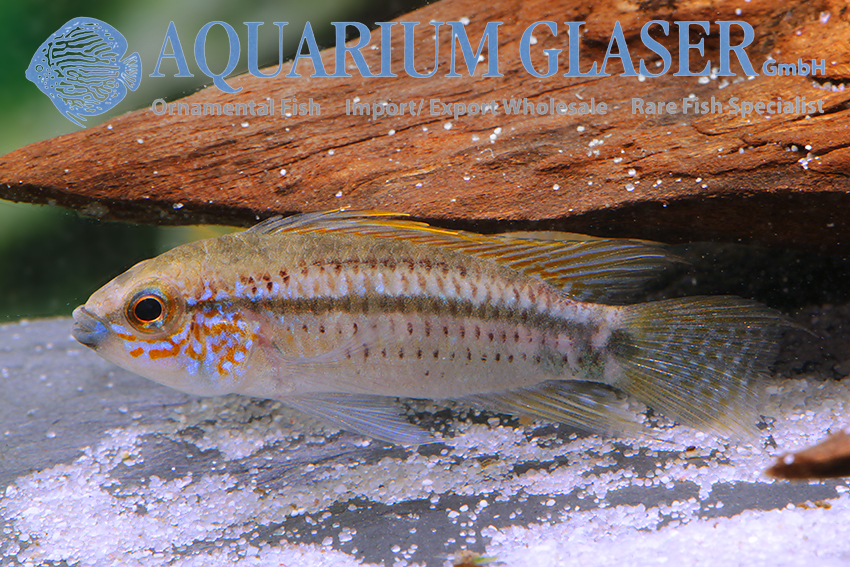
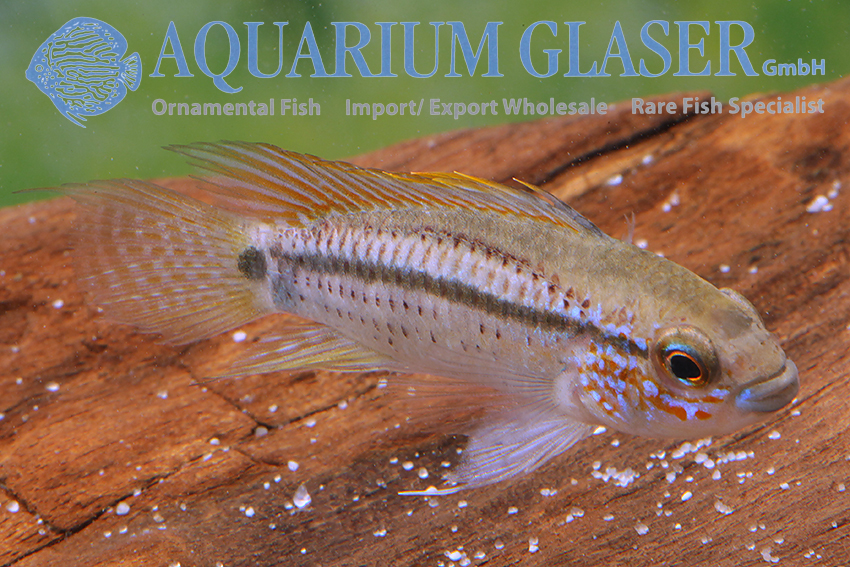
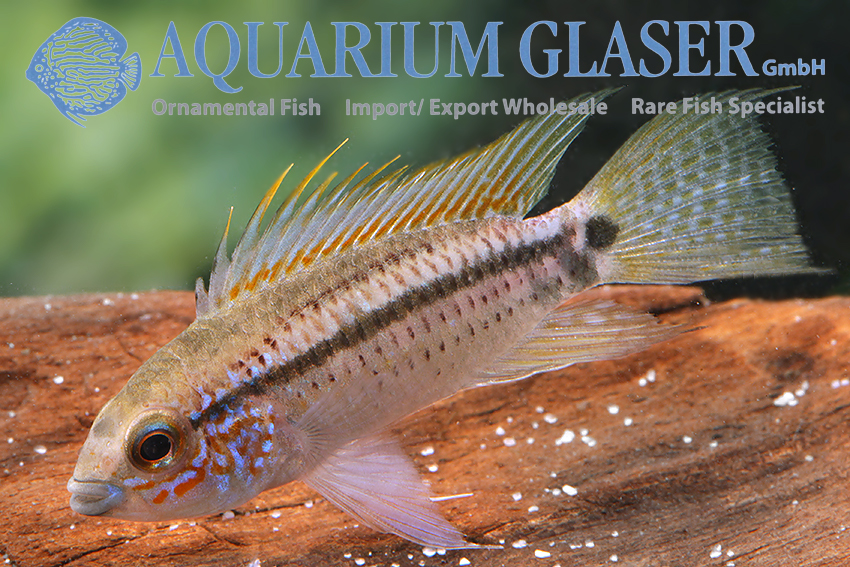
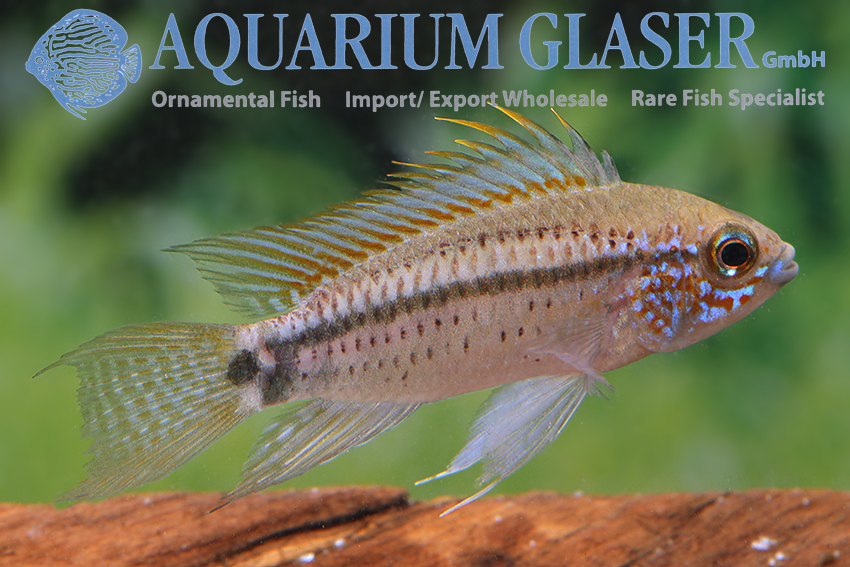
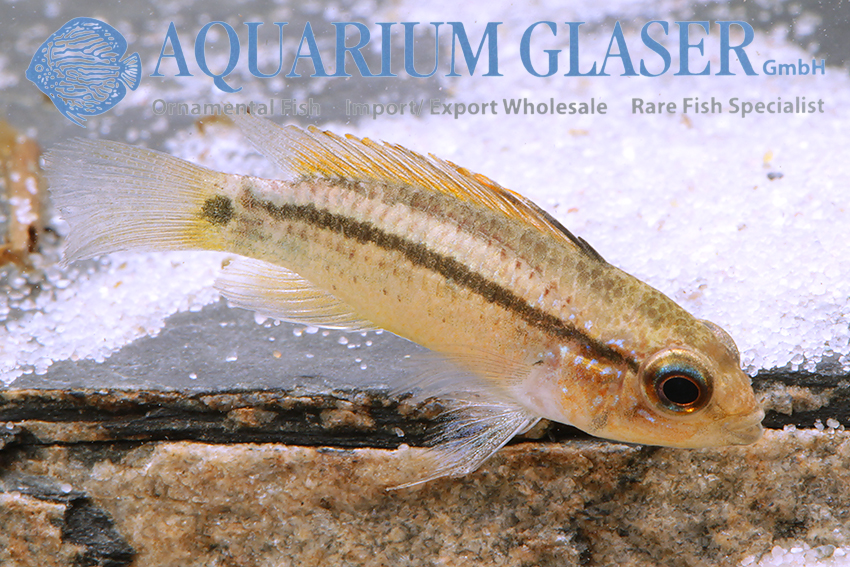
„King Barbarossa lives!
A new, wonderful dwarf cichlid has now been imported from Peru for the first time. The species is still unknown both scientifically and aquaristically.
The species is collected in the Tapiche river, a tributary of the Ucayali river, near Requena. Mr Edgard Panduro named the species Apistogramma “BARBAROJA”, i.e. “red beard”, because of the conspicuous red spots on the face. While in the last time mainly new species and new variants around Apistogramma cruzi and A. nijsseni made the hearts of the dwarf cichlid fans beat faster, this Apistogramma is from a completely different site. It reminds in various respects of A. bitaeniata, which is also one of the most beautiful Apistogramma species. At first sight, however, the new “Redbeard” can be distinguished from all known Apistogramma species by the large tail spot, which has not yet become known from any dwarf cichlid in this form.“
Then, in July 2004, Ready and Kullander described the species as Apistogramma eremnopyge based on specimens collected two years earlier by Oliver Lucanus in the Rio Pintuyacu (drainage of the Rio Itaya), 48 km on the road from Iquitos to Nauta (Loreto Province in Peru).
Since then, unfortunately, it has become quite quiet about this pretty little fish. Sexually mature wild specimens are usually not larger than 5 cm, females always stay smaller, but it is of course possible that the species grows a bit larger if kept in aquaria for a long time. In any case, it is a true dwarf cichlid.
We are very happy to have this species in our fishhouse again after a long time. Currently it is called Apistogramma “Diamond” in the trade, in the past it was sometimes called Apistogramma sp. “Fresa” or “Strawberry” (both mean strawberry).
For our customers: the animals have code 628792 on our stocklist. Please note that we only supply wholesale.
Text & photos: Frank Schäfer
Apistogramma elizabethae
On wednesday we received wild collected Apistogramma elizabethae. Anytime we get such rarities we take an even closer look than anyway on the fishes wether they really belong to the ordered species and if bycatches are among them. Apistogramma elizabethae can be told apart from other, similar species by an unique feature: alarmed fish loose much of their coloration and show two horizontically arranged oval spots on the flanks. This double spot can be also seen under special light conditions in relaxed fish, but it is much less obvious then.
So we took our documentary photos and discovered a male that looked totally different from all Apistogramma-elizabethae males we have ever seen before: it had broad vertical bars on the belly! We selected the fish and two others to take a closer look in the phototank. But here the male didn´t show that coloration anymore. Instead it came very quickly in mood for sexual activities and delivered a fabulous combat with his likeness in a small pocket mirror. These fish are simply gorgeous!
For our customers: the animals have code 618712 on our stocklist. Please note that we exclusively supply the wholesale trade.
Text & photos: Frank Schäfer
A cryptic species of Dicrossus?

Dicrossus filamentosus, the checkerboard cichlid, is a permanent guest in our fishhouse. The beautiful dwarf cichlids make gorgeous aquarium inhabitants.






Last week we obtained a shipment of large specimens from Manaus, almost exclusively males. We decided to photograph them due to their brilliant coloration.

During selecting the models for the photo aquarium two unusual facts became obvious. First: one of the males was extraordinary deep bodied. And twice: there was no female in the shipment that showed the typical red ventral fins of sexually active females.

Instead the selected female showed two features that were also found in the unusual deep bodied male: the black marks along the side were almost quadratic (instead of rectangular) and there was a small black spot on the basis of the ventral fins (lacking in “normal” checkerboards).





Of course this can be pure chance. But it is also possible that the unusual checkerboards represent a hidden, so-called cryptic, different species. Since genetic analyses (DNA-analyses) have become so cheap, it has been found that cryptic species, which can be hardly told apart from well known species by external features, but which are totally different from a genetic point of view, are comparatively common.
For our customers: the Dicrossus filamentosus we currently have in stock have code 668002 (sm) and 668005 (lg-xlg) on our stocklist. Please note that we exclusively supply the wholesale trade.
Text & photos: Frank Schäfer
Gorgeous Dicrossus maculatus arrived!


Dicrossus
maculatus belongs for sure to the most beautiful dwarf cichlids at all.
But we hardly ever have seen so pretty specimens like the ones we
currently were able to import!


The
photos are taken from specimens we currently have in stock. The water
in the photo-tank has been coloured with dead leaves to a strong amber
colour in order to make the fish feel as comfortable as possible.
However, on the photos this gives a impression of more yellow-orange
coloration on the body than is extant. But we hesitated to correct this
by Photoshop, for the overall colours would look unnatural in that case.

For our customers: the animals have code 668506 on our stocklist. Please note that we exclusively supply the wholesale trade.
Text & photos: Frank Schäfer
Ram Electric Blue Orange Head

We received a small number of German bred specimens of this spectacular new sport.


For our customers: the animals have code 686752 on our stocklist. Please note that we exclusively supply the wholesale trade.
Text & photos: Frank Schäfer





